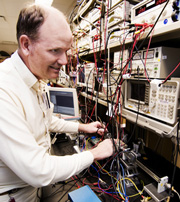
| Home | About Us | Contribute | Bookstore | Advertising | Subscribe for Free NOW! |
| News Archive | Features | Events | Recruitment | Directory |
| FREE subscription |
| Subscribe for free to receive each issue of Semiconductor Today magazine and weekly news brief. |
News
28 November 2008
UCSD reports 58% PAE for wireless base-station power amplifiers
Three years after breaking the 50% barrier for power added efficiency (PAE), at last month’s 2008 IEEE Compound Semiconductor IC Symposium (CSICS) in Monterey, CA, USA researchers from the University of California, San Diego (UCSD) reported achieving an average PAE of 58% – a record for a single-stage WCDMA base-station power amplifier – with average output power of 42W and a gain of 10.2dB.
Cell-phone reception depends on the strength of signals coming to and from wireless base-stations, the range of which depends on high-power amplifiers that typically have 10% efficiency (i.e. consume ten times more power than they generate). At 58% PAE, 50W of output power would require only 86W of DC power, rather than the 500W required by existing 10%-efficient high-power base-stations. The UCSD study also reports what is claimed to be the best improvement in linearization.
To attain better linearity and the 58% PAE for a WCDMA WiMAX base-station power amplifier, the researchers used high-voltage heterojunction bipolar transistors (HVHBTs) based on gallium arsenide, rather than either the silicon-based technology used in most existing 3G base-stations, or the gallium nitride metal-semiconductor field-effect transistor (MESFET) used to demonstrate the record 50% average PAE in 2005.
“GaAs HVHBTs are attractive options, since they can provide both high voltage and high efficiency and gain over wide dynamic range signals,” says lead author Donald Kimball, principal development engineer at Calit2 (the California Institute for Telecommunications and Information Technology). “Having high efficiency over wide dynamic range is critical because in 3G systems the demand for power varies widely from instant to instant, given the wide variety of modern cell-phone communications that go well beyond voice calls.”
The transistor devices were fabricated using the GaAs HVHBT process of TriQuint Semiconductor Inc of Hillsboro, OR, USA. As with their earlier work, the UCSD engineers combined the heterojunction device with a technique known as envelope tracking, which involves variable power signals instead of the constant feed of DC voltage that is common in high-power amplifiers. The technique adjusts voltage dynamically while reducing the heat generated by the transistor and allowing the amplifier to operate closer to saturation.
“TriQuint provided Calit2 with 15 transistors with a custom on-package match for Envelope Tracking Technology,” says Kimball. “They also sent their top engineers to our facility to work with our students on the project.” The CSICS paper was co-authored by three TriQuint engineers (Craig Steinbeiser, Thomas Landon and Oleh Krutko). Co-authors at UCSD include Jacobs School of Engineering electrical and computer engineering (ECE) professors Peter Asbeck and Larry Larson, as well as ECE graduate students Myoungbo Kwak, Jinho Jeong, Chin Hsia and Paul Draxler (who is also an engineer at Qualcomm Inc). The record was achieved during tests in the High-Power Amplifier Laboratory of Calit2’s UCSD Division.
 According to UCSD, two wireless infrastructure manufacturers – Finland’s Nokia and China-based HuaWei – have already expressed interest in the findings.
According to UCSD, two wireless infrastructure manufacturers – Finland’s Nokia and China-based HuaWei – have already expressed interest in the findings.
Picture: Calit2 principal development engineer Don Kimball runs tests in Calit2’s Power Amplifier Lab.
See related item:
TriQuint launches 3G base-station amplifiers that halve waste heat
![]() Search: WCDMA base-station PA GaAs HBTs TriQuint
Search: WCDMA base-station PA GaAs HBTs TriQuint
Visit: www.calit2.net